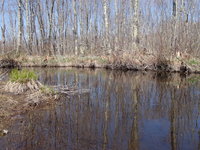New rules coming to help fish navigate Maine's culverts
Intresting concept
TED KOFFMAN and GEORGE SMITH
July 24, 2009
Maine's prized wild and native brook trout, wild Atlantic salmon and other important fish and aquatic life travel up and down streams and brooks seeking food, spawning areas, or cooler water on hot summer days.
Unfortunately, all too often their travel is blocked by thousands of roadway culverts that are too small, improperly installed or poorly maintained.
The net effect of blocked passage is the slicing and dicing of habitat. As habitat is degraded by problem culverts, natural fish reproduction is reduced and populations decline.
Local wildlife extinctions and loss of diversity may result. These losses may result in the need for costly stocking of hatchery-raised fish, a less-satisfactory replacement for wild populations.
This is a significant wildlife management issue. A recent survey of the Lower Penobscot River found 91 percent of 533 crossings present passage problems. Of these, 54 percent had severe problems.
Thirty-eight percent of culverts had constrained outlets, and 79 percent of the culverts did not span the full width of the channel.
The survey also found that culverts that limit aquatic organism passage are most frequently found to be undersized structures. And most of these sites would not meet current design criteria for fish passage.
This year the Maine Legislature took a very important step to address this problem and ensure the sustainability of Maine's wild and native fish and aquatic species by passing LD 1333, "An Act to Ensure that Replacement Culverts Permit Fish Passage" (sponsored by Speaker Hannah Pingree).
LD 1333 amends existing exemptions to the Natural Resources Protection Act requiring natural stream flow be maintained to allow fish to swim up and down stream when culverts or crossings are repaired or replaced. It also provides for aquatic organism passage.
In addition, the bill calls for the Maine Department of Environmental Protection to amend its shortened permitting process known as "permit-by-rule" to require municipalities to support natural stream flow when roads and stream crossings are repaired or maintained. These rules will come back to the Legislature for approval.
As our climate changes and water temperatures increase, it is even more essential that fish be able to move throughout their habitat in order to survive. As weather events become more extreme, wildlife habitat in Maine will change dramatically.
Trees and vegetation that thrive in a warmer climate will stretch farther north, as Maine's spruce and fir, now at the southern edge of their territory, retreat toward Canada. Many wildlife species already at-risk and tied to unique habitats may not be able to adapt fast enough, and those that can adapt will only be able to do so if they can move across Maine's changing landscape to find usable habitat.
The risk for species extinctions will rise significantly, as will the number of species on the state's endangered and threatened list.
Expanding protection to aquatic organisms is critical to ecosystem protection. Aquatic organisms are wildlife that depend on waterways for part of their life cycle such as breeding, migration, foraging, or population dispersal.
These include invertebrates (freshwater mussels, crayfish, aquatic insects), amphibians (stream salamanders), and reptiles (turtles). The entire aquatic ecosystem is linked, and all species depend on each other for food and in some cases reproduction.
Protecting our wildlife resources is critical for Maine's economy and quality of life. The value of our natural environment is Maine's brand and a draw to the rest of the world. The total expenditures in Maine on wildlife-related recreation in 2006 was $1.5 billion.
Doing the right thing now will also save money in the future. Adequately sized culverts will reduce downstream erosion and have longer life spans and reduced maintenance needs, resulting in significant cost savings over time. It's a sensible investment.
On behalf of Maine Audubon, Maine Rivers, Atlantic Salmon Federation, Maine Council of Trout Unlimited, and Sportsman's Alliance of Maine, we applaud the Maine Legislature for making this significant step forward in aquatic wildlife conservation and look forward to working with interested parties on the rulemaking process




What's Related